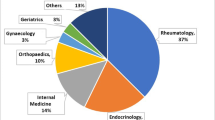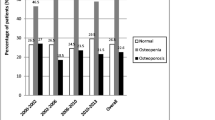Abstract
Introduction
Osteoporosis poses a significant public health problem for ageing Australians. However, approximately 25 % of Australian adults aged 20–49 years have osteopenia, a precursor condition to osteoporosis. Despite this, little is known about bone density testing in this age group.
Methods
Reasons for referral to dual energy X-ray absorptiometry (DXA) were examined in 2,264 patients aged 20–49 years, referred in 2001–2010 to the Geelong Bone Densitometry Service, Geelong Hospital, Victoria. Referral reasons were determined from clinical indication codes derived from patient records. Age, sex and bone mineral density (BMD) T scores were ascertained for each patient.
Results
The most common reason for referral for women reflected glucocorticoid use, and for men reflected fracture. Compared to women, men were more likely to have been referred because of minimal trauma fracture or low BMD (41.7 versus 27.1 %, p < 0.001). No further differences were identified between the sexes, with similar numbers of referral observed for secondary osteoporosis, and monitoring of drug therapy. At the spine, and for all indications, men had a significantly greater BMD deficit compared to women (all p ≤ 0.002). After age adjustment, men who were tested due to fracture or glucocorticoid reasons had significantly greater BMD at the total hip (p ≤ 0.03). No further associations were seen after age adjustment between referral reason and BMD.
Conclusions
Our study presents the first data examining reasons for referral to DXA among Australians aged 20–49 years. Understanding health service utilisation regarding bone health in young adults is fundamental to understanding future risk, informing effective public health messages and raising awareness of osteoporosis.
Similar content being viewed by others
References
ABS (2009) National health survey: users’ guide, electronic publication, 2007–2008. http://www.abs.gov.au. Accessed 17 January 2012
Henry MJ, Pasco JA, Nicholson GC, Kotowicz MA (2011) Prevalence of osteoporosis in Australian men and women: Geelong Osteoporosis Study. Med J Aust 195:321–322
Iversen MD, Vora RR, Servi A, Solomon DH (2011) Factors affecting adherence to osteoporosis medications: a focus group approach examining viewpoints of patients and providers. J Geriatr Phys Ther 34:72–81
Australian Institute of Health and Welfare (2011) A snaphot of osteoporosis in Australia 2011. Cat. no. PHE 137. AIHW, Canberra
Kanis JA, Melton LJ 3rd, Christiansen C, Johnston CC, Khaltaev N (1994) The diagnosis of osteoporosis. J Bone Miner Res 9:1137–1141
Kayan K, de Takats D, Ashford R, Kanis JA, McCloskey EV (2003) Performance of clinical referral criteria for bone densitometry in patients under 65 years of age assessed by spine bone mineral density. Postgrad Med J 79:581–584
Sanders KM, Seeman E, Ugoni AM, Pasco JA, Martin TJ, Skoric B, Nicholson GC, Kotowicz MA (1999) Age- and gender-specific rate of fractures in Australia: a population-based study. Osteoporos Int 10:240–247
Kanis JA, Johnell O, Oden A, Jonsson B, De Laet C, Dawson A (2000) Prediction of fracture from low bone mineral density measurements overestimates risk. Bone 26:387–391
ABS (2005) Population by age and sex, regions of Australia. Cat no. 3235.0
Pasco JNG, Kotowicz M (2011) Cohort profile: Geelong Osteoporosis study. Int J Epidemiol 40:1–11
Korpelainen R, Korpelainen J, Heikkinen J, Vaananen K, Keinanen-Kiukaanniemi S (2006) Lifelong risk factors for osteoporosis and fractures in elderly women with low body mass index—a population-based study. Bone 39:385–391
Ahlborg HG, Johnell O, Nilsson BE, Jeppsson S, Rannevik G, Karlsson MK (2001) Bone loss in relation to menopause: a prospective study during 16 years. Bone 28:327–331
Pasco JA, Kotowicz MA, Henry MJ, Panahi S, Seeman E, Nicholson GC (2000) Oral contraceptives and bone mineral density: a population-based study. Am J Obstetrics Gynecology 182:265–269
Haapasalo H, Kannus P, Sievanen H, Pasanen M, Uusi-Rasi K, Heinonen A, Oja P, Vuori I (1996) Development of mass, density, and estimated mechanical characteristics of bones in Caucasian females. J Bone Miner Res 11:1751–1760
Pasco JA, Kotowicz MA, Henry MJ, Sanders KM, Seeman E, Nicholson GC (2004) Hormone therapy and risk of non-vertebral fracture: Geelong Osteoporosis study. Osteoporos Int 15:434–438
Mirza FS, Prestwood KM (2004) Bone health and aging: implications for menopause. Endocrinol Metab Clin North Am 33:741–759
Pasco JA, Seeman E, Henry MJ, Merriman EN, Nicholson GC, Kotowicz MA (2006) The population burden of fractures originates in women with osteopenia, not osteoporosis. Osteoporos Int 17:1404–1409
Henry MJ, Pasco JA, Nicholson GC, Seeman E, Kotowicz MA (2000) Prevalence of osteoporosis in Australian women: Geelong Osteoporosis study. J Clin Densitom 3:261–268
van Staa TP, Leufkens HG, Cooper C (2002) The epidemiology of corticosteroid-induced osteoporosis: a meta-analysis. Osteoporos Int 13:777–787
Singer BR, McLauchlan GJ, Robinson CM, Christie J (1998) Epidemiology of fractures in 15,000 adults: the influence of age and gender. J Bone Joint Surg Br 80:243–248
Donaldson LJ, Cook A, Thomson RG (1990) Incidence of fractures in a geographically defined population. J Epidemiol Comm Health 44:241–245
Otmar R, Henry MJ, Kotowicz MA, Nicholson GC, Korn S, Pasco JA (2011) Patterns of treatment in Australian men following fracture. Osteoporos Int 22:249–254
Acknowledgments
SL Brennan is the recipient of NHMRC Early Career Fellowship (1012472). This study was supported by a Strategic Grant from The University of Melbourne (601158). We thank Yvonne Birch for her assistance in accessing the data.
Author information
Authors and Affiliations
Corresponding author
Rights and permissions
About this article
Cite this article
Torpy, A.M.J., Brennan, S.L., Kotowicz, M.A. et al. Reasons for referral to bone densitometry in men and women aged 20–49 years: population-based data. Arch Osteoporos 7, 173–178 (2012). https://doi.org/10.1007/s11657-012-0094-z
Received:
Accepted:
Published:
Issue Date:
DOI: https://doi.org/10.1007/s11657-012-0094-z




